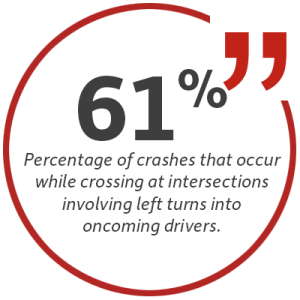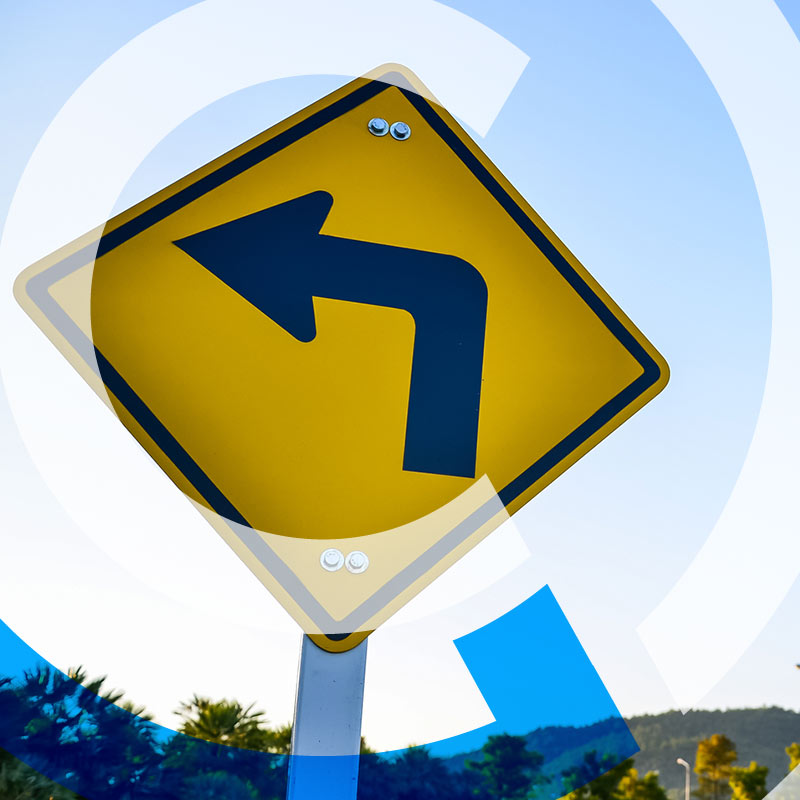Car accidents are one of the leading causes of injuries in the United States and left-turn crashes are one of the most common kinds of car accidents. The National Highway Traffic Safety Administration (NHTSA) reports that 61% of crashes that occur while crossing at intersections involve left turns into oncoming drivers. Left turn accident damage can be very serious.

An unprotected left turn is when you turn into an intersection where oncoming cars have the right of way.
Unprotected left-hand turns are more dangerous than right-hand turns for distracted driving for a variety of reasons. A left-turn driver turning left must pay attention to oncoming traffic, judge how fast they’re driving, and keep an eye on the traffic signals or a stop sign.
More reasons why left-turn car accidents are common when a left-turning vehicle goes across oncoming traffic include:
- Left-hand turns tend to disrupt the flow of traffic.
- The right-of-way can be hard to determine in complex intersections.
- Many drivers forget or choose not to use turn signals.
- Most drivers accelerate when turning across oncoming traffic.
- Drivers making a left-hand turn must watch out for cars coming from multiple directions.
What to Do After a Left-Turn Accident in Indiana
In the event of a left-turn accident in Indiana, your health is your number one priority, so seek medical treatment first. After you’ve been assessed and treated by a doctor, taking specific steps to protect your rights and potential compensation for accidents during left turns is imperative.
Here are the most critical steps to take next:
- Contact Your Insurance Company: Call your insurance company and give them essential information about the accident. However, exercise caution and refrain from speculating about the cause of the crash or admitting fault. Providing factual details without unnecessary assumptions is crucial at this stage.
- Follow-Up Medical Treatment: Adhere diligently to your doctor’s prescribed treatment plan. Consistent follow-up enhances your overall prognosis and serves as evidence to insurers that you are actively seeking recovery and preventing the exacerbation of injuries. This commitment to medical care can be pivotal in establishing the extent of damages incurred.
- Maintain a Journal: Keep a daily journal documenting your pain levels to demonstrate the sustained pain and suffering over time. Additionally, make notes of any activities you find challenging or impossible to perform due to the injuries sustained in the accident. Detailing emotional distress is equally important, providing a comprehensive view of the impact on your overall well-being.
- Exercise Caution on Social Media: While social media is a standard means of communication, exercise caution in discussing how the accident happened. Refrain from mentioning specific details about the incident and avoid posting photos that could misconstrue your physical condition. Insurance companies frequently monitor claimants’ social media profiles, making it essential to prevent anything that could be used to deny or minimize a claim.
- Consult an Attorney: Connect with an experienced car accident attorney as soon as possible, especially if disputes about fault arise or significant injuries have been sustained. An attorney can play a vital role in safeguarding your rights, guiding you through the legal process, and advocating for fair compensation. Early consultation allows for a thorough assessment of the case and ensures the preservation of critical evidence.
By following these guidelines, individuals involved in left-turn accidents can enhance their chances of a fair and just resolution.
By taking proactive measures in communication, medical care, documentation, and legal representation, individuals can navigate the left turn accident damage with greater confidence and protection of their rights.
Types of Left Turn Accident Damage
Accidents that occur to a driver turning left, can result in a range of injuries, varying in severity. The nature and extent of injuries vary depending on the speed of the vehicles involved, the angle of impact, the use of seat belts, and the presence of airbags.
Some common types of injuries that may occur in left-turn accidents include:
- Whiplash: Sudden acceleration or deceleration during a left-turn collision can cause whiplash. This soft tissue injury affects the neck and upper back, leading to pain, stiffness, and potential long-term complications.
- Fractures: The impact force in a left-turn accident can result in fractures, often occurring in the arms, legs, or ribs. Fractures vary in severity, from minor hairline fractures to more severe breaks.
- Head Injuries: A traumatic brain injury (TBI) is a severe type of head trauma that can occur if the head hits something hard, either with the steering wheel, dashboard, or other objects within the vehicle. TBIs can range from mild concussions to severe injuries with lasting cognitive effects based on how fast oncoming traffic was going.
- Spinal Cord Injuries: Severe left-turn accidents may lead to spinal cord injuries, which can result in paralysis or long-term disability. The impact on the spine can damage the nerves and affect various bodily functions.
- Internal Injuries: Impact forces in a left-turn collision can cause internal injuries, such as organ damage or internal bleeding. These injuries may not be immediately apparent, making prompt medical evaluation crucial for timely treatment.
- Soft Tissue Injuries: Beyond whiplash, left-turn accidents can cause various soft tissue injuries, including contusions, strains, and sprains. These injuries may result from the sudden jolts and movements during the collision.
- Emotional Distress: In addition to physical injuries, left-turn accidents can cause emotional distress, including anxiety, depression, and post-traumatic stress disorder (PTSD). The psychological impact of a traumatic accident should not be overlooked, as it can significantly affect a person’s overall well-being.
Who is Liable for The Left Turn Car Accident Damage?
When determining fault and liability, it may seem initially obvious who is at fault. While driving rules vary by state, one common law is that drivers must yield when making turns – especially a driver making left turns.
Left-turn drivers generally must wait for oncoming cars until it’s safe to turn across traffic. This means that if left-hand turns result in an accident, even if an oncoming vehicle collides with the other, the driver making the left-hand turn will be deemed at fault. Failing to yield for oncoming traffic qualifies as negligence, and injured accident victims have a valid personal injury case.
However, there are some cases where the driver of the car making a left turn may not be negligent, including:
- If the turning driver has a left turn arrow and the other driver went through a red light.
- If the non-turning driver went through a stop sign.
- If the non-turning driver violated traffic laws.
How Accident Liability is Established in Indiana

Indiana operates under a fault insurance system, when an accident occurs the party responsible for the accident becomes liable for covering the resulting damages. A standard method employed to determine liability involves a thorough review of relevant traffic laws to identify any violations that may have occurred.
The left-hand turn accident could have been caused by one or both drivers involved, with both drivers breaching traffic regulations.
Common traffic violations contributing to left-turn accidents include:
- Speeding.
- Driving while distracted or impaired.
- Pulling out in front of left-turning drivers.
- Running red lights or speeding up after a green light changes.
- Failing to yield at stop signs.
- Following too closely.
- Failing to yield the right-of-way.
Left Turn Accident Damage Assumptions
In left-turn accidents, the driver making the left hand turn is often automatically considered negligent since the onus is usually on the other driver who possesses the right-of-way. Consequently, in the event of a left hand side collision, there’s a presumption that the left-turning vehicle driver executed the maneuver without allowing sufficient space and time.
Nevertheless, the left turn driver might challenge this presumption by presenting evidence that the other driver accelerated after the green traffic light, when the other driver’s traffic light turned yellow, ran a red light, or committed another traffic violation. Investigators will also scrutinize the police report generated for the incident.
Reasons The Driver Turning Left May Not Be Liable
Determining fault in a left-turn accident in Indiana can be intricate and isn’t always straightforward. While the left hand turning driver typically carries a substantial share of the blame, there are instances where they may not be entirely at fault.

The conduct of the oncoming driver can influence the assignment of blame away from the left-turning driver under certain circumstances, such as when the oncoming driver:
Speeding: If the driver approaching from the opposite direction exceeds the speed limit or engages in reckless driving at excessive speed, they could be deemed partially or entirely at fault for the accident.
Running a Red Light: Other drivers who fail to adhere to traffic signals and collide with a vehicle lawfully at traffic lights or make a left turn when cross traffic is present, would be considered the at-fault driver for the incident.
For example, if an injured driver is 10 percent responsible for a car crash while the other driver shoulders 90 percent of the fault. However, any awarded compensation will be reduced by the percentage of fault in a left turn accident, attributed to the injured driver. For instance, if the injured victim is granted $10,000 in damages, the final compensation will be 10 percent less, resulting in a total of $9,000.
Illegal Passing: If the oncoming vehicle engages in illegal passing maneuvers at the time of the left-turn collision, the driver of that vehicle may be held accountable.
Sudden and Unexpected Actions: If the oncoming car takes sudden and evasive actions that leave the left-turning driver with no reasonable means to avoid a collision, the responsibility could shift from the left-hand driver to the oncoming driver.
Failure to Yield: The driver approaching the fast oncoming traffic at the intersection might need to yield, even if the left-turning driver has a protected green arrow. This failure to yield could establish fault in a left turn accident.
Partial Responsibility in a Left-Turn Collision
Within Indiana’s framework of comparative fault, individuals involved in a car accident can seek compensation for serious injuries, even if they bear partial responsibility, as long as their share of fault is less than 51 percent. However, it’s important to note that the awarded damages will be adjusted based on the individual’s percentage of blame for the collision.
How Long Do I Have to File a Left Turn Car Accident Claim in Indiana?

Understanding the legal constraints surrounding the timeframe for filing your claim is crucial for individuals involved in car accidents in Indiana. The statute of limitations, a legal timeframe within which a claim must be filed, is a pivotal factor in determining the viability of seeking compensation for losses incurred in an auto accident here.
In Indiana, the statute of limitations for filing a personal injury claim for such accidents is typically two years from the accident date. Individuals seeking compensation for injuries, property damage, or other losses from a left-turn car accident case have two years to initiate legal proceedings.
Failure to file your auto accident claim within the stipulated two-year period may cost you the right to seek compensation. Once the statute of limitations expires, the legal system may bar any attempts to collect evidence or bring a lawsuit, leaving the injured party without recourse for pursuing financial recovery.
The two-year statute of limitations in Indiana is a fixed timeframe designed to balance the interests of all parties involved in a legal dispute.
Statute of Limitations Exceptions
While the general rule stipulates a two-year window for filing a claim in Indiana, unforeseen circumstances may influence or alter this timeframe.
Understanding these factors is crucial for individuals navigating the aftermath of left-turn accidents:
- Discovery of Injuries: In some cases, injuries sustained in a car accident may not become apparent immediately. The statute of limitations may be extended to accommodate situations where the full extent of injuries becomes known later.
- Minors Involved: If a minor is involved in a car accident, the statute of limitations may be tolled until the individual reaches the age of 18. This provision aims to protect the rights of minors who cannot independently pursue legal action.
- Governmental Entities: Special rules may apply if a car accident involves a government entity. Claims against government entities often have shorter notice periods, necessitating prompt action to preserve the right to seek compensation.
Act Quickly to Protect Your Rights
The importance of taking timely action in the aftermath of a car accident cannot be overstressed. Initiating the legal process well within the two-year timeframe allows for a thorough assessment of damages, collection of evidence, and engagement in negotiations with insurance companies.
Consulting with a legal professional early in the process so we can provide guidance on the specific deadlines applicable to the case, ensure all necessary documentation is collected, and help navigate the legal complexities involved in seeking compensation.
Why It’s Important to Hire an Attorney
Because sometimes even the most seemingly straightforward cases can be complicated, working with car accident lawyers to determine liability is essential.
One of our knowledgeable attorneys can thoroughly evaluate your case to confirm the other driver caused the left-hand turn collision and determine the left turn accident damage. And that you’re eligible for personal injury damages. We can also gather evidence like photo documentation, crash reports filed by police officers, and expert testimonies.
Crossen Law Firm Can Help
With years of experience, the seasoned car accident attorneys at Crossen Law Firm understand that injuries can be emotionally taxing and financially expensive. As if it wasn’t challenging enough to navigate lost wages and every unforeseen circumstance occurs, you may also have mounting severe medical costs, bills, and property damage you can’t afford.
Crossen Law Firm: Indianapolis Personal Injury Attorneys
We operate on a contingency fee basis to be as accessible as possible, so you don’t need to worry about paying our lawyers until we win your case. We are here to answer every left turn accident faqs, determine who had the right-of-way, and help you prove you weren’t at fault in a left turn accident.
Contact Crossen Law Firm online or by phone at (317) 401-8626 for a free case evaluation for your left turn accident case. Our personal injury lawyers are fierce advocates for those wrongly harmed by negligent drivers.

 317-401-8626
317-401-8626 
.jpg)